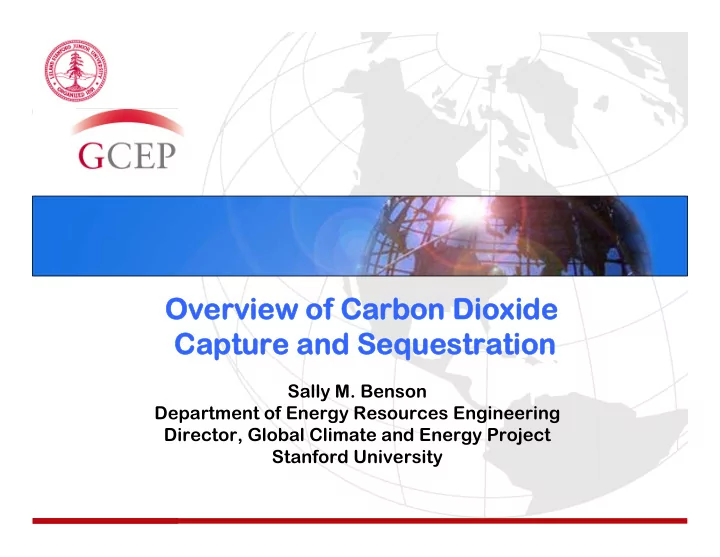

Overview of Carbon Dioxide Overview of Carbon Dioxide Capture and Sequestration Capture and Sequestration Sally M. Benson Department of Energy Resources Engineering Director, Global Climate and Energy Project Stanford University 1
Summary Summary • Why is it important? – Fossil fuels will continue to be the major source of energy for the foreseeable future – Without CCS it will be difficult to meet emissions reduction targets of 50 to 80% by 2050 • How much sequestration capacity is available? – Estimates indicate sufficient capacity for sequestering emissions for over the next century – Experience and research will improve reliability • Will it leak back to the atmosphere and how will we know? – Seals providing a permeability and capillary barrier can retain buoyant fluids for geologic time scales – Careful site selection and operations with regulatory oversight – Many monitoring methods are available – with more to come 2
What is Carbon Dioxide Capture and Storage and Why is it Important? • Carbon dioxide capture and sequestration technology can slow global warming by reducing carbon dioxide emissions into the atmosphere • Applicable to the 60% of global emissions that come from stationary sources such as power plants • Necessary to achieve the rapid and sustained carbon dioxide emission reductions over the next 50 3 to 100 years
Carbon Dioxide Capture and Geologic Sequestration is a Four Step Process • How much sequestration capacity do we have? • Will it leak back out? Pipeline Underground Pipeline Underground Capture Compression Compression Capture Transport Injection Transport Injection 4
Types of Rock Formations Suitable for Geological Sequestration Deep sedimentary basins are suitable for CO 2 sequestration. 100 miles Northern California Sedimentary Basin 1 inch Example of a sedimentary basin with alternating layers of sandstone and shale. Sandstone 5
Basic Concept of Geological Sequestration of CO 2 • Injected at depths of ~ 1 km or deeper • Primary trapping – Beneath seals of low permeability rocks Courtesy of John Bradshaw • Secondary Trapping Mechanisms – Dissolution, residual gas trapping, and mineralization 6
Sequestration Site Selection Criteria Overburden Known condition of active and abandoned wells Known condition of activ e and abandoned wells Presen Presence of m ce of multiple s ltiple secon condary seal ary seals Geographically ex Geographicall exten tensive ive Low Low perm permeability and high capillary en eability and high capillary entry pressure try pressure Seal Stable and sealed faults and fractures Stable and sealed faults and fractures High mech High m chanical strength anical strength Deeper than 800 m Deeper than 800 m Not a source of drinking water Not a source of drinking water Sequestration Satisfactory permeability Satisfactory permeability Suff Sufficient sequestration volume icient sequestration volume Formation Hydrologically isolated Hydrolog ically isolated from drinking water from drinking water aquifers aquifers Large with open Large with op en bo boundaries daries 7
North American Sequestration Resources in Oil and Gas Reservoirs Oil and gas reservoirs could potentially store about 60 years of current emissions from power generation. 8
North American Sequestration Resources in Coal Beds Unminable coal formations could potentially store about 80 years of current emissions from power generation. 9
North American Sequestration Resources in Saline Aquifers Saline aquifers could potentially store more than 1,000 years of current emissions from power production. 10
Key Technical Issues About Capacity in Saline Aquifers Prospective Saline Aquifers • Continued refinement of capacity estimation methodology – Current approach is based on a fraction of the pore space – Limited by injection pressure? – Limited by seal continuity? • Storage resource to storage reserve? 11
Seal Rocks and Trapping Mechanisms • Seal rock geology – Shale, clay, anhydrite, carbonates • Two trapping mechanisms – Permeability barriers to CO 2 migration – Capillary barriers to CO 2 migration Capillary Barrier Effectiveness 1000 1000 Entry Pressure (Bars) Entry Pressure (Bars) 100 100 10 10 1 1 Delta Plain Shelf Delta Plain Shales Channel Channel Pro-Delta Shales Pro-Delta Delta Front Shales Delta Shelf Carbonates Abandonment Silts Shales Carbonates Abandonment Shales Front 12 Silts Shales
Lessons Learned from Natural Gas Storage and Waste Disposal • Major sources of leakage through seals – Injection wells – Abandoned wells – Undetected faults and fractures in the seal – Damage to seal from hydraulic fracturing – Inadequate monitoring • These were all adequately addressed through regulation – Permits for siting and injection operations – Well completion standards – Injection pressure limits – Routine monitoring and reporting S.M. Benson (2005) “Lessons Learned from Natural and Industrial Analogues,” Carbon Dioxide Capture for Storage in Deep Geologic Formations—Results from the CO2 Capture Project , Vol. 13 2: Geologic Storage of Carbon Dioxide with Monitoring and Verification , Elsevier Publishing, UK, p. 1133-1141.
Summary Summary • Why is it important? – Fossil fuels will continue to be the major source of energy for the foreseeable future – Without CCS it will be difficult to meet emissions reduction targets of 50 to 80% by 2050 • How much sequestration capacity is available? – Estimates indicate sufficient capacity for sequestering emissions for over the next century – Experience and research will improve reliability • Will it leak back to the atmosphere and how will we know? – Seals providing a permeability and capillary barrier can retain buoyant fluids for geologic time scales – Careful site selection and operations with regulatory oversight – Many monitoring methods are available – with more to come 14
Recommend
More recommend